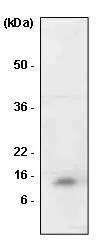![Western blot analysis of GeneTexs IgY fraction of Chicken-anti-Human MIF polyclonal antibody shows the detection of 100 microg of recombinant MIF present in a lysate. Similar detection of MIF will occur when human serum is analyzed. In lane 1 no reaction is observed in the control whereas lane 2 shows a single band at 12.3 kDa. A 4-20% gradient gel was used to separate the proteins by SDS-PAGE. The protein was transferred to nitro-cellulose using standard methods. After blocking the membrane was probed with the primary antibody for 1 h at room temperature followed by washes and reaction with a 1:5,000 dilution of IRDye800 conjugated Gt-a-Chicken Rabbit IgG [H&L] for 1 h at room temperature. LICORs OdysseyR Infrared Imaging System was used to scan and process the image. Other detection systems will yield similar results. Western blot analysis of GeneTexs IgY fraction of Chicken-anti-Human MIF polyclonal antibody shows the detection of 100 microg of recombinant MIF present in a lysate. Similar detection of MIF will occur when human serum is analyzed. In lane 1 no reaction is observed in the control whereas lane 2 shows a single band at 12.3 kDa. A 4-20% gradient gel was used to separate the proteins by SDS-PAGE. The protein was transferred to nitro-cellulose using standard methods. After blocking the membrane was probed with the primary antibody for 1 h at room temperature followed by washes and reaction with a 1:5,000 dilution of IRDye800 conjugated Gt-a-Chicken Rabbit IgG [H&L] for 1 h at room temperature. LICORs OdysseyR Infrared Imaging System was used to scan and process the image. Other detection systems will yield similar results.](https://www.genetex.com/upload/website/prouct_img/normal/GTX48478/GTX48478_20160330_WB_w_23060823_846.webp)
Western blot analysis of GeneTexs IgY fraction of Chicken-anti-Human MIF polyclonal antibody shows the detection of 100 microg of recombinant MIF present in a lysate. Similar detection of MIF will occur when human serum is analyzed. In lane 1 no reaction is observed in the control whereas lane 2 shows a single band at 12.3 kDa. A 4-20% gradient gel was used to separate the proteins by SDS-PAGE. The protein was transferred to nitro-cellulose using standard methods. After blocking the membrane was probed with the primary antibody for 1 h at room temperature followed by washes and reaction with a 1:5,000 dilution of IRDye800 conjugated Gt-a-Chicken Rabbit IgG [H&L] for 1 h at room temperature. LICORs OdysseyR Infrared Imaging System was used to scan and process the image. Other detection systems will yield similar results.
MIF antibody
GTX48478
ApplicationsWestern Blot, ELISA
Product group Antibodies
TargetMIF
Overview
- SupplierGeneTex
- Product NameMIF Antibody
- Delivery Days Customer9
- Application Supplier NoteWB: 1:500-1:2000. ELISA: 1:1000-1:5000. *Optimal dilutions/concentrations should be determined by the researcher.Not tested in other applications.
- ApplicationsWestern Blot, ELISA
- CertificationResearch Use Only
- ClonalityPolyclonal
- Concentration5 mg/ml
- ConjugateUnconjugated
- Gene ID4282
- Target nameMIF
- Target descriptionmacrophage migration inhibitory factor
- Target synonymsGIF, GLIF, MMIF, macrophage migration inhibitory factor, L-dopachrome isomerase, L-dopachrome tautomerase, epididymis secretory sperm binding protein, macrophage migration inhibitory factor (glycosylation-inhibiting factor), phenylpyruvate tautomerase
- HostChicken
- IsotypeIgY
- Protein IDP14174
- Protein NameMacrophage migration inhibitory factor
- Scientific DescriptionPro-inflammatory cytokine. Involved in the innate immune response to bacterial pathogens. The expression of MIF at sites of inflammation suggests a role as mediator in regulating the function of macrophages in host defense. Counteracts the anti-inflammatory activity of glucocorticoids. Has phenylpyruvate tautomerase and dopachrome tautomerase activity (in vitro), but the physiological substrate is not known. It is not clear whether the tautomerase activity has any physiological relevance, and whether it is important for cytokine activity.
- Storage Instruction-20°C or -80°C,2°C to 8°C
- UNSPSC12352203







